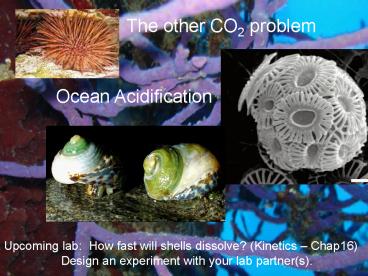Ocean Acidification - PowerPoint PPT Presentation
1 / 26
Title:
Ocean Acidification
Description:
Sea water 'wants' more carbonate, so it 'takes' it from the ... Echinoderms (sea urchin) Calcite. The Solutions. What can we do about ocean acidification? ... – PowerPoint PPT presentation
Number of Views:3450
Avg rating:5.0/5.0
Title: Ocean Acidification
1
The other CO2 problem
Ocean Acidification
Upcoming lab How fast will shells dissolve?
(Kinetics Chap16) Design an experiment
with your lab partner(s).
2
What is Ocean Acidification?
When CO2 is added to water, the pH
decreases CO2 (g) ? CO2 (aq) ? H2CO3 (aq) ?
HCO3- (aq) H (aq) ? CO32- (aq) H (aq)
pH - logH
Average pH of the ocean 8.1 pH decreases
with depth Along the WA coast surface pH
8.1, depth 7.6 (600 700 feet)
pH changes with increasing CO2 Rate of decrease
0.02 pH/decade (faster along coast)
3
pH decrease tracks CO2 increase
Since beginning of industrial revolution (1750s),
pH has dropped by 0.1 (30 inc in H)
4
The pH change is small Whats the big deal?
Seattle Times article pH changed from 8.1 to
7.6 along Pacific Coast of the US Average pH of
entire ocean has changed by 0.1 pH units (30
increase in H)
What is pH? pH a
measurement scale used to quantify
the concentration of hydrogen ions (H)
pH - log (H)
Take Home Message Small changes in pH represent
large changes in H concentration.
5
What makes ocean waters corrosive to
shell-building organisms?
Total Carbonate CO2 (aq) HCO3- (aq) CO32-
(aq)
Total Carbonate
6
Consequences of Ocean Acidification
7
Loss of marine biodiversity
Coral reefs harbor more than 25 of the oceans
biodiversity provide a refuge and feeding
ground for countless marine organisms. gt 50
of all corals reefs are in cold, deep waters
more impacted by ocean acidification
8
Loss of food sources (fish, shellfish, etc) for
subsistence food gathering
9
Loss of sources of income for local communities,
often in developing countries
Fishing
Ecotourism
10
Decrease in biological pump Removes CO2 from
the atmosphere.
Phytoplankton - Coccolithopores
11
Adapted from NASA Earth Observatory
http//earthobservatory.nasa.gov/Library/CarbonCyc
le
12
The Science
Why ocean acidification is occurring Why it
harms marine organisms
13
Why is Ocean Acidification Occurring?
1 Gt 109 metric tons 1015 grams 1 Gt 40,000
aircraft carriers
14
Spatial Distribution of Ocean Acidification
15
What makes ocean waters corrosive to
shell-building organisms?
Acidification or Increased Corrosiveness is due
to a Decrease in pH.
What is pH? pH a
measurement scale used to quantify
the concentration of hydrogen ions (H)
16
What makes ocean waters corrosive to
shell-building organisms?
When CO2 gas from the atmosphere dissolves in
water, H concentration increases.
17
Why does a decrease in CO32- ions spell trouble
for organisms ?
Shell-building organisms need CO32- ions for
their CaCO3 shells
Ca2 CO32- CaCO3
Shell dissolution Sea water wants more
carbonate, so it takes it from the shells
of organisms.
18
Why CaCO3 shells dissolve in seawater
Analogy Table salt (NaCl) dissolves when you
add it to a glass of tap water.
Salt dissolves
NaCl Na Cl-
(CaCO3 Ca2 CO32-)
19
(No Transcript)
20
All CaCO3 shells are not created equal
21
The Solutions
What can we do about ocean acidification?
22
A possible geoengineering solution Add CaCO3 to
the ocean.
Reduce CO32- under-saturation caused by excess
CO2 dissolving in ocean water.
Shells are made of CaCO3
Ca2 CO32-
Shells are made of CaCO3
Ca2 CO32-
H CO32-
Sounds great, but..
23
To counteract 2 Gt C/yr input of CO2, would need
20 Gt CaCO3/yr.
White Cliffs of Dover would be rapidly
consumed. Limestone Rock (CaCO3)
Limestone mining would be expensive and would
cause ecological damage. All the energy needed
to move massive amounts of rock into the ocean
would likely add more CO2 to the atmosphere.
24
What about Fe fertilization to take care of CO2
already in the atmosphere?
Biological Pump
Phytoplankton - Coccolithphores
25
Stop adding CO2 to the atmosphere
26
Brainstorming
How fast will shells dissolve?































